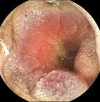Malignant complications of celiac disease: a case series and review of the literature
- PMID: 36503568
- PMCID: PMC9743581
- DOI: 10.1186/s13256-022-03682-3
Malignant complications of celiac disease: a case series and review of the literature
Abstract
Background: Celiac disease is an immune-mediated enteropathy triggered by gluten in genetically susceptible individuals. Diagnosis is based on evaluating specific autoantibodies and histopathologic findings of duodenal biopsy specimens. The only therapy for celiac disease is a gluten-free diet. Celiac disease can be complicated by malnutrition, other autoimmune diseases, refractoriness to treatment, and gastrointestinal tumors. This article presents seven cases of malignancies in patients with celiac disease. Its objective is to raise awareness of the malignant complications of celiac disease, leading to earlier diagnosis and improved outcomes.
Case presentation: Seven cases of malignant complications of celiac disease occurred among 190 patients followed at the Department of Internal Medicine and Gastroenterology, University Hospital Brno from 2014 to 2021. We describe these cases and the presentation, diagnostic process, course, management, and outcomes for each, along with proposed potential risk factors of malignant complications. There was one Caucasian man who was 70 years old and six Caucasian women who were 36, 46, 48, 55, 73, and 82 years old in our cohort. Of the seven cases of malignancies in our cohort, four patients were diagnosed with small bowel adenocarcinoma, one with diffuse large B-cell lymphoma, one with carcinoma of the tongue, and one with colorectal carcinoma.
Conclusions: Malignancies occurred in 3.7% of patients followed up for celiac disease. Awareness of the malignant complications of celiac disease, risk factors, presentation, and disease course could lead to earlier diagnosis and improved outcomes.
Keywords: Carcinoma; Case report; Celiac disease; Complication; Lymphoma; Malignancy.
© 2022. The Author(s).
Conflict of interest statement
The authors declare that they have no competing interests.
Figures






Similar articles
-
Monitoring nonresponsive patients who have celiac disease.Gastrointest Endosc Clin N Am. 2006 Apr;16(2):317-27. doi: 10.1016/j.giec.2006.03.005. Gastrointest Endosc Clin N Am. 2006. PMID: 16644460 Review.
-
Celiac disease: a clinical review.Abdom Radiol (NY). 2017 Feb;42(2):351-360. doi: 10.1007/s00261-016-1034-y. Abdom Radiol (NY). 2017. PMID: 28078381 Review.
-
[Small bowel adenocarcinoma diagnosed by video capsule endoscopy in a patient with celiac disease: a case report and review of literature].Vnitr Lek. 2020 Fall;66(7):39-42. Vnitr Lek. 2020. PMID: 33380133 Review. Czech.
-
[Histological diagnosis and complications of celiac disease. Update according to the new S2k guidelines].Pathologe. 2015 Mar;36(2):197-205; quiz 206-7. doi: 10.1007/s00292-015-0006-2. Pathologe. 2015. PMID: 25820446 Review. German.
-
[Primary small bowel neoplasms as a complication of celiac disease].Gastroenterol Hepatol. 2009 Nov;32(9):618-21. doi: 10.1016/j.gastrohep.2009.05.003. Epub 2009 Jul 21. Gastroenterol Hepatol. 2009. PMID: 19625106 Spanish.
Cited by
-
A Case Report of Celiac Disease and Small Bowel Adenocarcinoma: Two Diseases With Similar Symptoms.Cureus. 2025 Apr 11;17(4):e82086. doi: 10.7759/cureus.82086. eCollection 2025 Apr. Cureus. 2025. PMID: 40351992 Free PMC article.
-
Enhancing Self-Care Education in Celiac Disease Through Mobile Health: A Systematic Review.Health Sci Rep. 2025 Aug 6;8(8):e71086. doi: 10.1002/hsr2.71086. eCollection 2025 Aug. Health Sci Rep. 2025. PMID: 40777764 Free PMC article. Review.
-
Malignancies in Patients with Celiac Disease: Diagnostic Challenges and Molecular Advances.Genes (Basel). 2023 Jan 31;14(2):376. doi: 10.3390/genes14020376. Genes (Basel). 2023. PMID: 36833303 Free PMC article. Review.
References
Publication types
MeSH terms
Substances
Grants and funding
LinkOut - more resources
Full Text Sources
Medical

